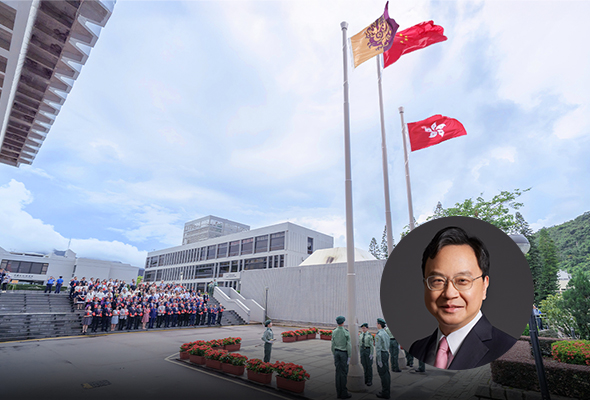A safe pair of robotic hands
Kwok Ka-wai’s robotic platform provides new level of agility in non-invasive cancer surgery
23 October 2025
This is part four of a series in which CUHK In Focus talks to leaders of six CUHK projects selected for the second round of the Hong Kong government’s Research, Academic and Industry Sectors One-plus (RAISe+) Scheme. It provides up to HK$100 million to each approved project, helping local universities transform, realise and commercialise their research and development (R&D) outcomes. Including the seven that were chosen in 2024, a total of 13 CUHK projects have received funding from the Scheme so far, the most among local institutions.
When he was still an MPhil student at CUHK’s Department of Automation and Computer-aided Engineering two decades ago, Kwok Ka-wai became fascinated by how robots could mimic human hands.
“I particularly liked how the coordination among could effectively lead to wide-ranging dexterity,” says the young academic. Now a professor at CUHK’s Department of Mechanical and Automation Engineering, this early interest led him to develop a robot capable of imitating the brushstrokes of legendary Chinese calligraphers such as Wang Xizhi, and set him on a long academic journey researching surgical robots.
Now, after almost two decades of research, he has developed a new system for dexterous robotic hands that allows clinicians to perform minimally invasive cancer surgeries, removing tumours without making external incisions.
“With this, we’ve expanded the range of access for surgical robots,” he says. In June, Professor Kwok was one of six CUHK academics to receive a RAISe+ funding boost for their R&D projects.
First, do no harm
The use of medical robots that pass through natural orifices to perform minimally invasive surgeries was already gaining traction by 2007, when Professor Kwok started along his R&D path. But there was a problem: “Traditional hand-operated tools are rigid, and can’t reach a lot of places in the human body for surgery,” he explains, holding up a conventional older instrument to illustrate his point. “With such low levels of dexterity, it’s all too easy to accidentally cut into unintended tissue, and that creates a whole new level of risk.”
Professor Kwok therefore committed himself to providing clinicians with a solution that would enable physicians and surgeons to perform even the most complex of minimally invasive surgeries in the narrowest of spaces. The result is a robotic system that allows medical professionals free and flexible machine movement within the patient’s body, instead of the traditional push-and-pull hand motions involved in such surgeries. To do so, two equally dexterous “hands”, remotely manipulated by surgeons from a control chair, are used. This enhancement in range of motion makes tight spaces like the urethra and colon more accessible for surgeries.
Easy to learn, easy to operate
Among surgeries facilitated by this new system is the resection (removal) of tumours in the bladder and intestines in one piece. With more than four million of gastrointestinal and bladder cancers reported each year in China, more technologically advanced surgical methods are urgently needed. A particular challenge in conventional minimally invasive surgeries is the need to navigate through a patient’s body to reach a tumour. By contrast, Professor Kwok’s new robotic platform enters the body through natural orifices, and can function in confined, hollow, spherical spaces to perform tumour resections.
For those keen to try his new system, especially younger medical professionals, Professor Kwok assures that the learning curve is gentle. No additional specialised equipment is needed as the system is compatible with hospital equipment already in use. Its versatility means it can complement a variety of endoscopes – long, thin tubes with a light and camera at the tip that allow surgeons to see inside a patient’s body.
Professor Kwok admits that achieving this harmony between machines developed in different technological eras was the biggest challenge: “Endoscopes are standard equipment in hospitals. We asked ourselves how we could accommodate their usage, so that the costs of adoption remained low.” Professor Kwok and his team came up with a solution that balanced robotic flexibility, durability and dexterity while being compatible with conventional endoscopes. The full use of both hands allows stability in endoscope viewing, and also measured movement. “Think of the endoscope as a car, bringing surgical tools to that part of the body needing surgery; we don’t want to change your driving habits, but we do want to get you into the optimum position for performing surgery,” says the professor. “With our system, we are no longer limited to the single-hand approach, and can dexterously separate and dissect tissue.”
Collaborating across disciplines
To refine his robotic system, Professor Kwok has partnered with professionals from other academic disciplines. Medical expertise has come in the form of Professor Jason Chan Ying-kuen, Clinical Professor and Chairman of the Department of Otorhinolaryngology, Head and Neck Surgery. Their collaboration bore fruit when the CUHK urology team carried out their first successful clinical trial on a bladder cancer patient in December last year using Professor Kwok’s apparatus. They have subsequently conducted nine more trials, and in each procedure, the patient was discharged a day or two after surgery, and experienced minimal side-effects in the following month.
With RAISe+ funding secured, the two professors are hopeful they can further develop the robotic system’s capacities to help with gastrointestinal surgeries. They also plan to leverage Professor Chan’s expertise in head and neck surgery to explore the system’s application in that field as well.
Another area of promise, says Professor Chan, is to develop the new system’s capabilities for suturing surgical wounds. “Occasionally in surgeries like this you need to deliberately cut into body tissue, so the robotic system also needs to have suturing capabilities.” This prevents complications from external wounds, further enhancing procedural safety.
Professor Kwok, who lectures on robotics, knows that the best robots are designed with application in mind. Having proven the feasibility of the robotic system, the two professors are now also working to maximise its commercial potential in the medical equipment market. They are applying for safety validation, and preparing comprehensive training materials to make the system more accessible to medical professionals.
They have also connected with experts who specialise in bladder or gastrointestinal tumour resection across the US and China, with Professor Chan and his American counterparts conducting pre-clinical trials with a prototype of the system during a visit there. The team has also contacted vendors in the industry to further the system’s commercialisation and facilitate future production. “In this respect, RAISe+ is definitely a big help to our development efforts,” says Professor Kwok. “We’re hoping it will unlock even more clinical responses for us.”
By Chamois Chui
Photos by Steven Yan






















